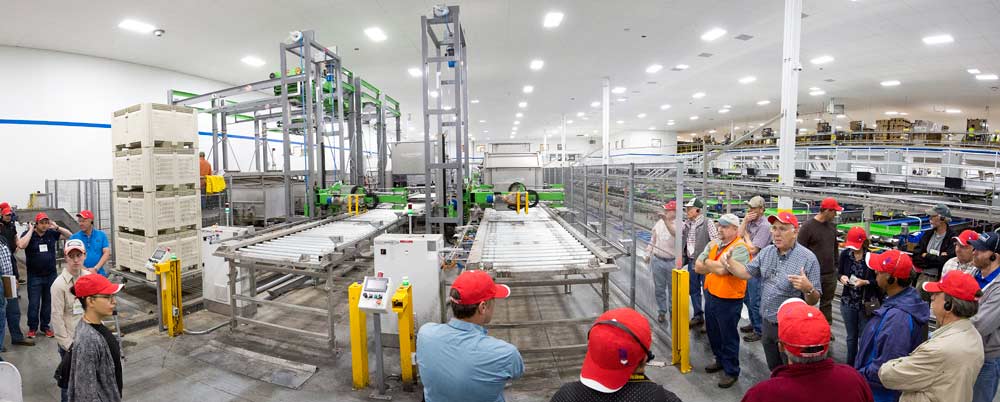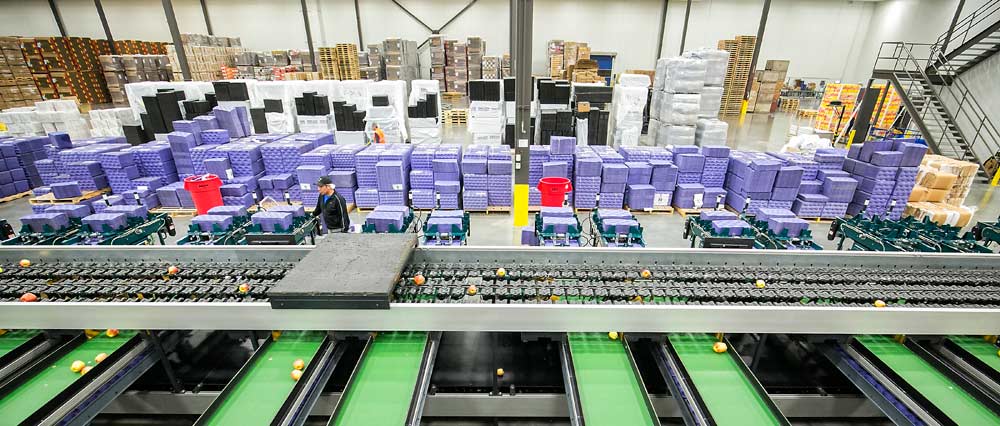
Blue Bird President Ron Gonsalves, right, speaks to attendees of the 2017 Interpera conference at the company’s new packing line in Wenatchee, Washington. Gonsalves discussed how the robotic systems and bin washing system help keep workers safer and meet higher-than-standard food safety regulations. The technology, though new to the industry, will become the standard among packers in the state, he said. (TJ Mullinax/Good Fruit Grower)
If only pears were round.
Then, the technological packing line developments crucial to keeping pears competitive in the global produce trade might already be here.
“Cherries and apples have benefited from technological improvements a lot over the past five years,” said Bob Gix, a pear grower from Wenatchee, Washington. “Pears have not to the same degree, and part of it has been because of the shape of the fruit.”
The elongated contour of pears prevents them from rolling smoothly over machinery that enables the high-tech electronic sorting, visioning and robotics tools that have rapidly changed the packing infrastructure of cherries and apples.
To give pear growers from around the world a glimpse of what could be, Gix and fellow Interpera conference organizers took attendees of the annual pear conference on tours of two of the more progressive Washington packers in the Wenatchee Valley.
The group saw packing lines known for modern tools such as automated bin runner washers, computer sorters and robotic pallet stackers.
Interpera, also known as the World Pear Congress, held its 10th annual meeting in June in Wenatchee, in the heart of the United States’ most prolific pear growing region.
The two-day event, the first held in the U.S., involved a mixture of conference room presentations, orchard tours and packing house tours to McDougall and Sons and Blue Bird Inc.
The good news about packing is that manufacturers around the world, such as Unitec of Italy, Maf of France and Greefa of The Netherlands, are racing to create new technology, Gix said. “It’s a wonderful time of competition that pear growers will benefit from.”
Blue Bird

Blue Bird President Ron Gonsalves speaks to one of two groups touring Wenatchee, Washington on the first day of Interpera 10th World Pear Conference on June 16, 2017. (TJ Mullinax/Good Fruit Grower)
At Blue Bird’s facility in Wenatchee, president Ron Gonsalves showed tourgoers a new packing facility built in the wake of a 2015 wildfire that destroyed the company’s last packing house there.
Designed as an apple line that can work with pears, with food safety and efficiency in mind, the line is dedicated organic.
The Maf equipment handles Bartlett and Anjou pears, but has not adapted to Bosc yet, due to the shape of the pear.
The company packs about 320,000 boxes of organic pears, roughly 30 percent of the Northwest’s organic volume, as well as almost 1.5 million conventional pear boxes from its main facility in nearby Peshastin.
The future mixes with the past at Blue Bird, a business that started in 1913 as a pear packer. In fact, there are still a few trees in the Wenatchee Valley as old as the company.
“There’s still Bartlett trees that are producing that are 100 years old. Not many of them, they’re kind of scattered around, but they do exist,” Gonsalves said.
He expects technology to change, figuring the facility will last 40 or 50 years, the equipment 15 or 20 years and the technology much less. “If we don’t do upgrades in three to five years, we will be surprised.”
The line can handle 200 bins of pears per shift, significantly less than the 450 to 500 bins of apples. For one thing, the shape makes it harder, but they also have fewer organic pears than apples.
Robotic bin washing is one of the newest features. A forklift driver delivers a pallet of four full bins. A system of five robots automatically dip each bin about 12 inches into a pressurized skid washer, immersion dumps the fruit, cleans each bin and nest stacks them.
Another feature is an automated, 12-drop bagging system that searches for pears of the correct weight to avoid overfilling. “The biggest frustration when you are doing hand filling with bags is giving weight away,” Gonsalves said.
McDougall & Sons

McDougall and Sons new packing line in East Wenatchee, shown here on Feb. 22, 2017, incorporates several types of automation, including these fruit and fiber pulp packing trays delivered together by machines to workers who align the fruit in boxes before shipment. (TJ Mullinax/Good Fruit Grower)
Bryon McDougall, packing operations coordinator for McDougall & Sons, led the Interpera tour group through the company’s new facility with computer-image sorting and automated features. Finished in 2015, it packs conventional apples, as well as both conventional and organic cherries.
McDougall and Sons could run pears over the same line, but apples chew up all its capacity, so the firm packs pears at a dedicated facility in nearby Monitor instead. But it would work.
“All the same technology is applicable to pears,” said McDougall, a fifth-generation member of the ownership family.
The McDougalls have considered upgrading the pear equipment, but are still looking for improvements to external defect sorting, while internal quality sorting isn’t a big concern with pears, McDougall said.
The apple and cherry facility has 24 controlled-atmosphere rooms, which each hold about 2,000 bins.
The company runs apples over two six-lane Greefa machines that work together using external and internal sorting technology.
Inside an operations room overlooking the expansive floor, computers display images of fruit with scores for brix, pressure, size, color and defects.
When sorting internal quality, cameras project upward through holes in each fruit cup on the conveyor belt to ensure each one is measured from the same distance. The company paid $90,000 to outfit each lane with internal sorting technology for apples.
The line runs 70 to 80 bins per hour. They would need four times the workforce to sort and grade all that fruit by hand.
Among the innovations are separated wet and dry sections of the process. The fruit enters the packing facility from the orchard through a “wet room,” where the bins are dunked and fruit is washed.
High-powered vents circulate the chlorine odor and dust away. The layout allows the company to keep noise and odors away from employees and consolidate most of the food safety risk into one room.
At the end of the process, McDougall also has invested in robotic pallet-building arms that do the work of 12 people more accurately.
The company also has automated bagging machines and moves them back and forth from the adjacent cherry line.
The apple and pear line features a scale that automatically selects the combination of fruit to make the right weight, like Blue Bird’s.
Again, the same machinery would work on pears, but pears take more effort. They must be wrapped, don’t have a tray-fill machine and don’t store as well as apples in bins. Instead McDougall and Sons packs 2-pound and 5-pound bags by hand at the Monitor facility.
McDougall estimates about 50 percent of pears end up in some form of consumer packaging during the fall and winter, but the number jumps to 80 percent in the spring and summer.
McDougall hopes the industry comes up with a way to store consumer packs, such as bags, in controlled-
atmosphere storage until shipment in May, June and July. Currently, the company packs fruit in 44-pound boxes in September and October and then repackages them for consumers later, a costly, labor-intensive chore.
“That’s really one of the big challenges for our industry, I think, is how we can extend our packing season or come up with better storage programs,” McDougall said. •
– by Ross Courtney






Leave A Comment